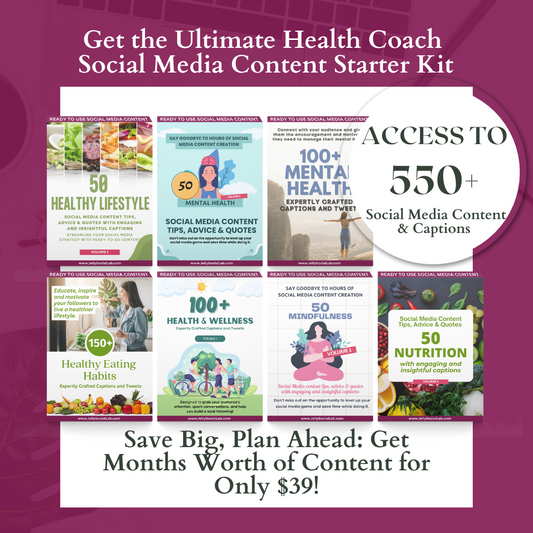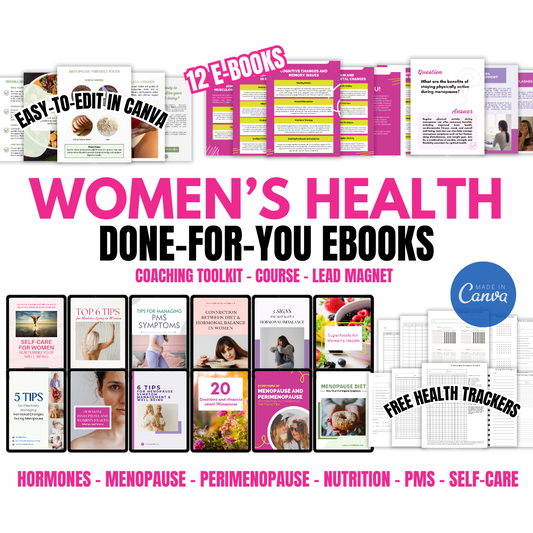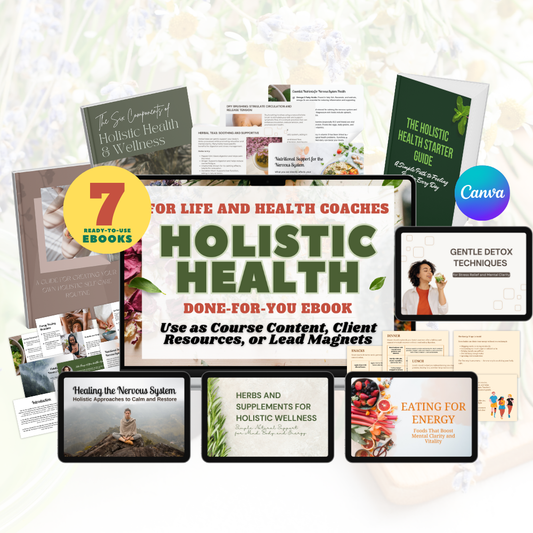
Marketing Your Wellness Practice When You Hate Marketing | Authentic Marketing Guide
Share
Let's be honest: you became a wellness professional to help people, not to sell to them.
The thought of "marketing yourself" probably makes you cringe a little. Or a lot. You didn't train in nutrition, therapy, coaching, or holistic health to become a salesperson. You just want to do the work you love with people who need your help.
But here's the problem: those people can't work with you if they don't know you exist.
The good news? Marketing doesn't have to feel gross, pushy, or inauthentic. When done right, it's simply showing up, being helpful, and making it easy for the right people to find you.
Here's how to market your wellness practice in a way that actually feels good.

Reframe What Marketing Actually Means
Most wellness professionals hate marketing because they think it means constantly promoting themselves, being salesy, or bragging about how great they are.
That's not marketing. That's being annoying.
Real marketing is about being visible to the people who need your help and making it easy for them to take the next step. It's about showing up consistently, providing value, and building trust over time.
Think of marketing as simply having a conversation with potential clients before they book with you. You're answering their questions, addressing their concerns, and helping them understand how you can support them.
When you shift your perspective from "selling" to "serving," marketing starts to feel a whole lot better.
Focus on Being Helpful, Not Promotional
The best marketing doesn't feel like marketing at all. It feels like someone sharing genuinely useful information.
Instead of posting "Book a session with me today!" focus on content that actually helps your audience right now. Share tips they can implement immediately. Answer common questions. Provide perspective on challenges they're facing.

When you consistently show up as a helpful resource, people naturally want to work with you at a deeper level. They've already experienced the value you provide through your free content. Working with you one-on-one becomes the obvious next step.
This approach works because it builds trust without triggering anyone's "I'm being sold to" defenses. You're not pushing. You're simply being useful, and people appreciate that.
Share Your Why, Not Just Your What
People don't connect with services. They connect with stories and purpose.
Instead of just listing what you do, share why you do it. What drew you to this work? What transformation did you experience that made you want to help others? What lights you up about supporting people in this specific way?
Your story makes you relatable and memorable. It helps ideal clients see themselves in your journey. It transforms you from "another wellness professional" into someone they feel like they already know and trust.
You don't need a dramatic origin story. Simple, honest sharing about why this work matters to you is powerful enough.
Talk to One Person, Not Everyone
One of the biggest marketing mistakes wellness professionals make is trying to appeal to everyone. The result? You end up connecting with no one.
Stop writing content for "people interested in wellness." Start writing for the specific person you most want to help. Picture them. What are they struggling with right now? What questions keep them up at night? What would make their life measurably better?
When you speak directly to one person's specific situation, everyone dealing with that situation feels seen. Your marketing becomes magnetic to the right people, even if it doesn't resonate with everyone.
This focused approach also makes marketing feel easier because you're not trying to be everything to everyone. You're just having a conversation with someone you genuinely want to help.
Show Up Consistently in Small Ways
You don't need to be everywhere all the time. You just need to show up consistently somewhere.
Pick one or two platforms where your ideal clients actually spend time. Maybe it's Instagram and email. Maybe it's Facebook and your blog. Maybe it's LinkedIn and a podcast.
Commit to showing up regularly in those spaces with something helpful. A weekly newsletter. Three social media posts per week. One blog post every two weeks. Whatever you can maintain without burning out.
Consistency builds familiarity. Familiarity builds trust. Trust leads to people actually booking with you. But none of that happens if you post sporadically or disappear for months at a time.
Small, consistent efforts always beat big, sporadic ones when it comes to marketing that works.
Use Other People's Words
If talking about yourself feels uncomfortable, let your clients do it for you.
Testimonials and success stories are some of the most powerful marketing tools you have. They provide proof that your approach works without you having to brag about yourself.
Make collecting feedback a natural part of your client process. When someone has a breakthrough or reaches a goal, ask if they'd be willing to share their experience. Most people are happy to do so.
Share these stories regularly. Feature them on your website, in your emails, and on social media. Let your clients' transformations speak louder than any promotional copy you could write.
This approach feels authentic because it is. You're not making claims about yourself. You're sharing real results from real people.
Create a Simple System You Can Actually Maintain
Complex marketing strategies fail because they're overwhelming. Simple systems succeed because you actually follow through with them.

Here's a simple weekly marketing routine that works:
- Monday: Share one helpful tip on social media
- Wednesday: Send your weekly newsletter
- Friday: Post a client win or testimonial (with permission)
- Throughout the week: Engage authentically with people who comment or reach out
That's it. Three pieces of content and consistent engagement. Nothing fancy. Nothing complicated. Just showing up regularly with value.
Adjust this framework to fit your capacity and preferences, but keep it simple enough that you'll actually do it week after week.
Make It Easy for People to Take the Next Step
You can be the most helpful, consistent, authentic wellness professional out there, but if people don't know how to work with you, they won't.
Every piece of content you create should have a clear next step. Not five options. One.
After sharing a breathing technique, invite people to download your free stress management guide. After discussing nutrition myths, offer a free discovery call. After explaining your approach, link to your booking page.
Make the path from "this person is helpful" to "I want to work with this person" as clear and simple as possible.
Many wellness professionals assume people will figure it out on their own. They won't. Tell them exactly what to do next and make it easy to do it.
Batch Create Content When You Feel Inspired
Nothing kills marketing momentum faster than forcing yourself to create content when you're not feeling it.
Instead, create in batches when inspiration strikes. When you're feeling energized and ideas are flowing, sit down and create multiple pieces of content at once.
Write three newsletter drafts. Record five short videos. Outline ten social media posts. Whatever format works for you, create multiples while you're in the zone.
Then schedule them out. This way you maintain consistency without having to force creativity on demand. You show up regularly even during weeks when you're busy with clients or just not feeling particularly inspired.
This approach honors your natural creative rhythms while still building the consistency your marketing needs.
Repurpose Everything
Create once, use multiple times. This single strategy makes marketing so much easier.
Turn your best social media posts into newsletter content. Transform your newsletter into blog posts. Pull quotes from blog posts for social media. Record yourself talking about a topic, transcribe it, and turn it into written content.

One good idea can fuel weeks of marketing across multiple platforms. You're not creating more work for yourself. You're maximizing the value of the content you're already creating.
This approach also ensures message consistency across platforms, which strengthens your brand and makes you more memorable.
Partner With People Who Don't Hate Marketing
You don't have to do everything yourself. Strategic partnerships with other wellness professionals can expand your reach without requiring you to do more marketing.
Find practitioners who serve the same audience but offer complementary services. A nutritionist and a therapist. A yoga instructor and a massage therapist. A life coach and a financial planner.
Create joint offerings, refer clients to each other, or collaborate on workshops. When you tap into each other's audiences, you get the marketing benefits without having to do all the work yourself.
Choose partners who share your values and approach. Their endorsement carries weight because their audience already trusts them.
Automate What You Can
Technology can handle some marketing tasks for you, freeing you up to focus on the parts that require your personal touch.
Use email automation for welcome sequences and follow-ups. Schedule social media posts in advance. Set up automated reminders for discovery calls. Create systems that keep things moving without requiring your constant attention.
This doesn't mean making your marketing feel robotic. It means using tools to handle the logistical pieces so you can focus on the genuine connection and value creation that only you can provide.
The goal is to make marketing take less mental energy while still maintaining consistency and effectiveness.
Use Done-For-You Content
You don't have to create everything from scratch. Quality templates and done-for-you content can dramatically reduce the time and energy marketing requires.
Pre-written emails, social media templates, and blog post frameworks give you a solid foundation to work from. You customize them with your voice and perspective, but you're not staring at a blank screen every time you need to create content.
This approach is especially helpful during busy seasons when you're focused on serving clients. You can maintain your marketing presence without sacrificing hours to content creation.
Ready-made content also ensures you're covering important topics consistently rather than only posting when inspiration strikes.
Give Yourself Permission to Market Your Way
The marketing advice you see online often comes from people in very different industries with very different values. Not all of it will fit your approach or feel authentic to you.
You don't have to do daily stories if that feels exhausting. You don't have to be on TikTok if you hate video. You don't have to use trending audio or dance if that's not your style.
Find the marketing methods that actually feel aligned with who you are. Maybe you're better at writing than video. Maybe you prefer email over social media. Maybe you thrive on in-person connections and local visibility.
There's no single "right" way to market a wellness practice. The right way is the one you'll actually sustain because it doesn't drain you.
Track What Actually Brings in Clients
Pay attention to what marketing efforts actually result in booked sessions.
You might discover that your monthly newsletter brings in more clients than your daily Instagram posts. Or that speaking at local events converts better than anything you do online. Or that word-of-mouth referrals outperform everything else.

When you know what works, you can do more of that and less of everything else. This makes marketing feel less overwhelming and more effective.
Don't just track vanity metrics like likes and followers. Track the actions that matter: email signups, discovery call bookings, and actual client conversions.
Remember: You're Not Bothering People
Many wellness professionals avoid marketing because they don't want to bother people or come across as pushy.
Here's the truth: the people who need your help are actively looking for it. They want to find someone like you. Your visibility isn't bothering them. It's helping them discover the support they've been searching for.
The problem isn't that you're showing up. The problem is when the right people can't find you because you're staying invisible.
Your ideal clients are out there right now, struggling with exactly what you help people with. They're not annoyed by your marketing. They're relieved to finally find someone who understands their situation and can guide them forward.
The Bottom Line
Marketing your wellness practice doesn't have to feel sleazy, pushy, or exhausting. When you approach it as serving rather than selling, it becomes a natural extension of the helpful work you already do.
Show up consistently. Be genuinely helpful. Share your story. Make it easy for people to take the next step. Use systems and tools that make marketing easier. Do it your way, not someone else's way.
You don't have to love marketing. You just have to do it consistently enough that the people who need you can actually find you.
Your work matters. Your approach helps people. Don't let discomfort with marketing keep you from reaching the clients who are looking for exactly what you offer.
Ready to make marketing easier? Check out our done-for-you email templates and pre-written content designed specifically for wellness professionals who want to show up consistently without spending hours on content creation. Get blog posts, social media content, and email sequences that feel authentic and actually attract your ideal clients.




